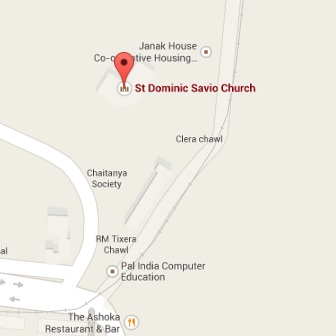There were about 20,000 residents mainly in the shanties made from sheets of tin and mats of bamboo.
There was no water, electricity and no sanitation.
Most of the residents were from South India, especially Madras (Chennai) who had come in search of jobs.
Land Surface: Swampy. There were big ponds. Located not far from salt pans.
Amidst the slums there were very few outstanding buildings whose residents were well paid government officers, office or factory workers and small business men.
A little ahead, there were four cemeteries: Catholic, European, Muslim, Chinese.
There were slums all around the cemeteries. The slum dwellers lived in inhumane conditions.
About 40% were Catholics and the other 60% comprised of Hindus, Muslims and others.
There were no schools, and the little children, instead of going to school, either worked or looked after their siblings while their parents worked.
A high crime area: Due to its proximity to the docks, this place became a haven for smugglers.
Slum lords reigned supreme on this no man’s land.
Rev. Fr. Matthew Thalanany put up an iron cross at the place where the Catholic cemetery stood.
He built a small tin shed and roofed it with leaves and branches. It was used as his office.
Thugs burnt it down. It was rebuilt but suffered the same fate.
By 1964, thanks to the goodwill of Mr. Madhavan, the then Mayor of Bombay, a bigger shed was built. It served as a Chapel.
Bishop Willie Gomes blessed the Chapel. It was dedicated to St. Anthony.
The hutment dwellers had the privilege of attending Holy Mass at least once a week.
Fr. Matthew was toying with the idea of building a Church when he stumbled over a forgotten piece of land which belonged to the Church.
Fr. Matthew immediately approached the Contractor- Mr. Lawrence, at that time building the ‘Eucress’ complex, and built a solid shed.
The shed was used for multiple purposes:
- To tutor the slum children as young as five and as old as eighteen.
- Medical assistance was provided to the slum dwellers.
- Regular Masses were conducted
- Summer vacations saw the Salesians working for the slum children.
Antop Hill was developing very fast and the need for a church was felt.
Fr. Matthew placed this urgency before Fr. Michael Mascarenhas, the then Provincial Economer, who entrusted the work to Mr. Gokar, the architect.
As Mr. Gokar was too slow, the work was shifted from Mr. Gokar to Mr. Raj.
At this time, Antop Hill was privileged to have distinguished guests like Rev. Fr. P. C. Thomas, The Regional Superior, Rev. Fr. Vecchi, In charge of youth Apostolate
Plans to build the Church were approved by Rome.
On 8th December 1978 at 4:30pm, the Foundation Stone was laid by His Grace Archbishop Simon Pimenta.
Present for the ceremony were the prominent Salesians including Fr. Aurelius Maschio-The Salesian Pioneer, Fr. Tony D’Souza-The Salesian Provincial and others.
This was an auspicious day for the Salesians as it was the golden jubilee of their work in the Province of Bombay.
The work of the construction of the Church actually began on 20th Aug. 1979.
Fr. Vigano sdb, the then Rector Major who visited India at the time, blessed the model of the new Church.
The Ceremony was held in Fr. Maschio’s office in the presence of prominent Salesians on 28th Sept 1979.
“God On The First Floor” was the headline that was printed in many leading newspapers all over the country in 1981 announcing the birth of a new church at Wadala (E), Bombay.
This was the first ‘L’ shaped house of worship in the city and the first to be erected on the first floor.
Today, St. Dominic Savio parish is a large and vibrant parish with around 10,000 parishioners belonging to various communities and different cultural backgrounds.


